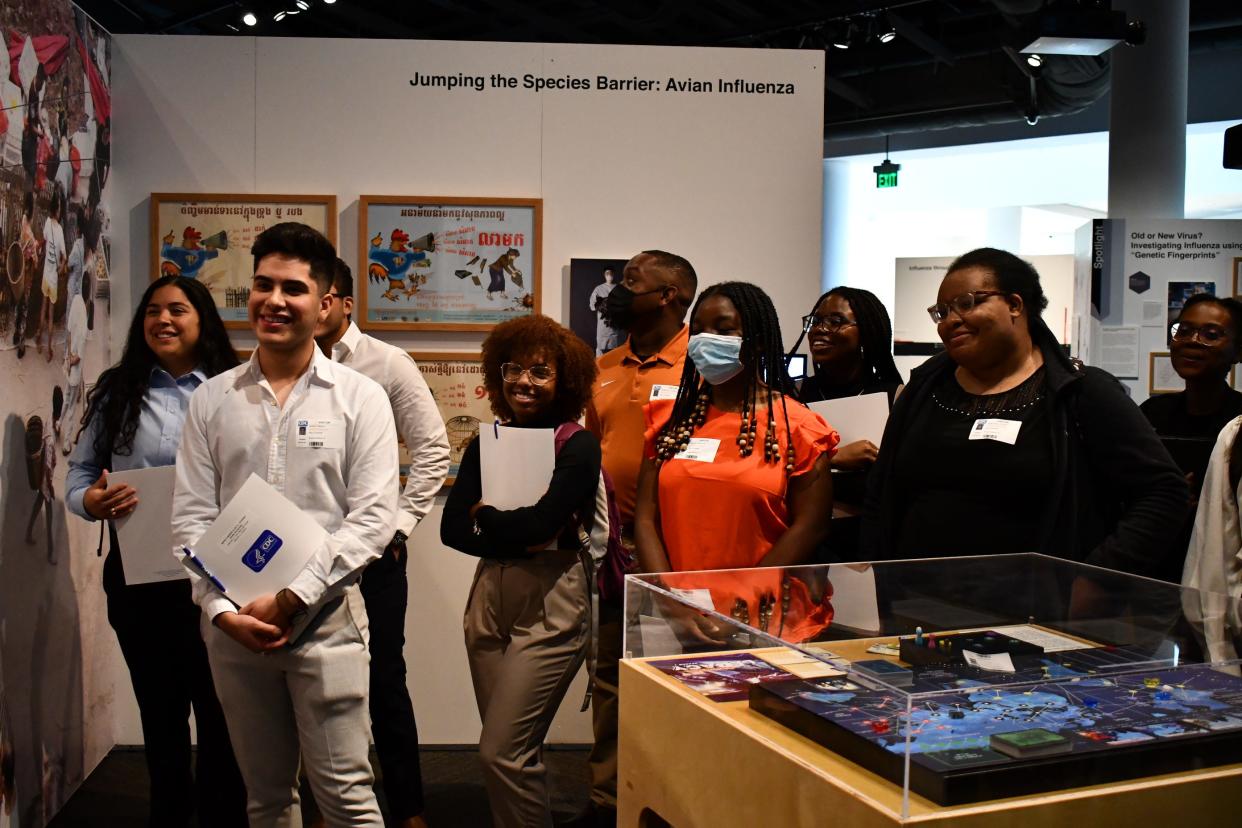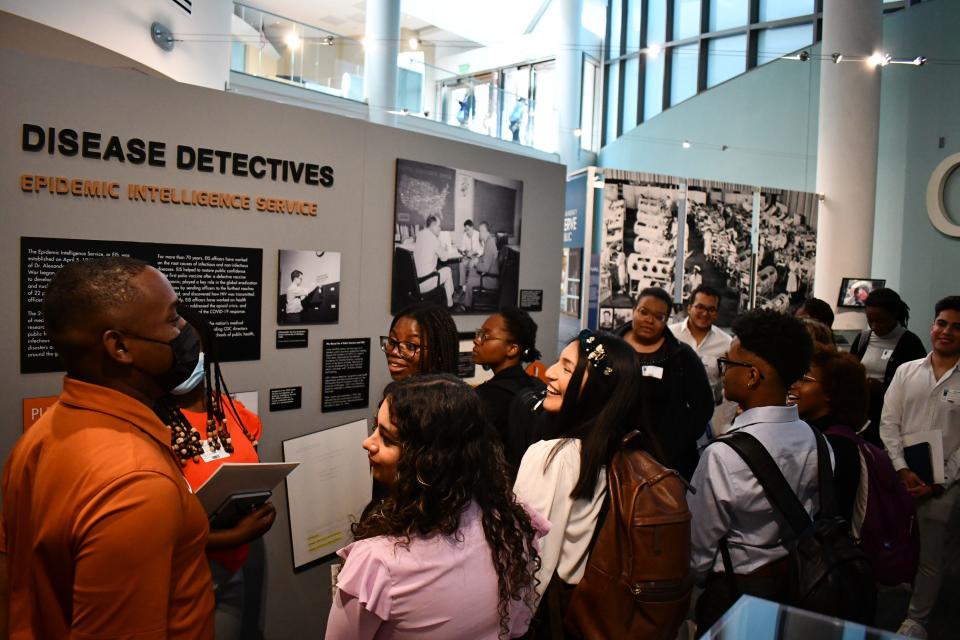Texas students of color travel to CDC for first Health Equity Exposure Experience

Shaltiy-El Jackson’s lifelong love for science motivated her to pursue medicine. However, the biology freshman said she saw the lack of diversity within the field in her first year of studies.
“Whenever I would do things like shadowing or volunteering, there weren’t people that I could relate to,” Jackson said.
Black and Hispanic students make up less than 20% of the University of Texas Dell Medical School’s student body, according to 2021 Texas Higher Education Board data. In an effort to better support underrepresented student populations and promote equity in the medical field, Jackson and 14 other Black and Hispanic pre-health students at UT visited the federal Centers for Disease Control and Prevention in Atlanta as part of the Health Equity Exposure Experience from April 27 to May 1.
“Many of us are first generation (college students), so our parents don’t really have those connections,” Jackson said. “It’s a really beneficial trip to allow us to get out there and show what we’re able to do and connect ourselves.”
More: UT Austin releases 10-year plan to become 'highest impact' public research university
'The value is in their lived experiences'
The program was a partnership with Dell Medical School’s Health Professions Pathway Program and was predominantly funded and organized by the UT Division of Diversity and Community Engagement, according to Dr. Octavio Martinez, associate chair of diversity, equity and inclusion at Dell Medical School.
“This program … is exactly the kind of innovation that is needed in public health,” CDC Director Dr. Rochelle P. Walensky said in a video to the students in the program. “We are grateful you are a part of it, carrying the torch for health equity.”
At the CDC, students engaged with health professionals, sharing their own experiences, passion for health equity and solutions to combat medical racism.
“The value is in their lived experiences,” said Ryan Sutton, assistant dean of diversity, equity and inclusion for Dell Medical School. “We see the underrepresentation of historically marginalized groups within these spaces, so the fact that we can walk into these spaces (as) Black and brown individuals, adds a level of insight that (the medical professionals) can get.”
More: Urban slave quarters rediscovered at Neill-Cochran House near UT in West Campus
At Georgia Tech University, the students also toured the sports medicine facilities and participated in a Q&A session with members of the sports medicine staff. Students asked panelists about physical and mental wellness in sports medicine, various disparities within the profession and how to succeed in this field.
Throughout the trip, the students were joined by notable medical professionals from the CDC, the Morehouse School of Medicine and others to provide networking and mentorship opportunities. In addition, the students and faculty visited the National Center for Civil and Human Rights as well as Martin Luther King Jr. National Historical Park.
Exploring health equity

While the trip focused primarily on students’ experiences and current disparities, historical health inequalities and the history of distrust between communities of color and the health care field were not left out of the conversation.
During the CDC visit, students got to tour the museum on campus, and the guide put an emphasis on health equity dating back centuries and on medical racism. During the tour, they specifically discussed the 1932 Tuskegee experiment in which hundreds of Black men unknowingly infected with syphilis were studied under the false pretense that they were receiving free medical care and were never offered any treatment.
“Being a Black woman in the United States, I have seen firsthand and heard stories of the mistreatment of Black women as well as other minorities and how uncomfortable (it) can be to go to the doctor, to go to the dentist (or) any sort of medical professional,” said Bisona Yangni, a health and society junior. “I want to do what I can to help alleviate that stress from people.”
Survey: Nearly 1 in 3 University of Texas students lack access to affordable, healthy food
Today, disparities continue as Black women are three to four times more likely to die from pregnancy-related causes than white women, according to the American Medical Association.
Black and Hispanic physicians made up approximately 11% of active physicians in the U.S. in 2018, according to the Association of American Medical Colleges. Black and Hispanic people make up nearly 32% of the U.S. population, according to the most recent census data.
“When you witness the disparities within your own community, you really get to see how the system isn’t perfect,” said Ginata Lopez, a health and society junior. “When I found out about health equity and the political and social determinants of health care, it made me want to fix it and advocate for people.”
‘Will this world let me be a doctor?’
Public health sophomore Faith Folorunso said she feels excitement about her future in the health care field and sparking change within the industry. However, she said, at times, she grows weary of how realistic a future in health is for her as a Black woman, especially at UT, where she is surrounded by white classmates.
“I’m used to dreaming so big, but there’s always the fear of my color not allowing me to fulfill my dreams, based on how I see the world treat minorities,” Folorunso said. “I want to be a doctor, but will this world let me be a doctor?”
According to 2021 Texas Higher Education Board data, Dell Medical School student population is nearly 60% white. In comparison, approximately 47% of the total medical school student population across the country in 2021-22 is white, according to data gathered by the Association of American Medical Colleges.
Sutton and Steve Smith, associate dean for student affairs, speaking for Dell Medical School, said the issues within the school causing these disparities in race are a result of systemic barriers, and officials are trying to start conversation about working to improve that.
Dell Medical School also fosters programs like one in which racial minority students are placed in mentor groups with local physicians from diverse programs, and has numerous student organizations aimed at supporting and creating a safe community for underrepresented minorities. Sutton said this initiative acts as both a temporary solution for a much larger issue and the tentative beginning of more efforts to prioritize diversity, equity and inclusion.
“We have work to do,” Sutton said. “There is a diverse, talented and gifted pool of future health professionals seeking admission into medical schools across this country. As we continue to seek to improve diversity in representation, we must continue to examine our procedures, policies and practices to ensure they are equitable and inclusive.”
Several students said this trip reignited their love for medicine, public health policy and health equity advocacy. Throughout the course of the trip, multiple professionals referred to the students as the “future of medicine.”
“You get to have an impact on these professionals that are already established in the field and offer them a sense of your experience (and) what you feel the health care industry needs,” neuroscience junior Diobenhi Castellanos said. “That’s really impactful because high school me would never (have thought) I’d ever be given an opportunity like this.”
This story was originally published by The Daily Texan, the independent newspaper produced by University of Texas students.
This article originally appeared on Austin American-Statesman: UT students of color travel to CDC for Health Equity Exposure Experience

